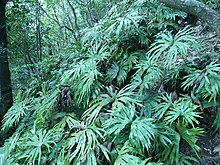Dipteris
| Dipteris | |
|---|---|

| |
| Dipteris conjugata | |
| Scientific classification | |
| Kingdom: | Plantae |
| Clade: | Tracheophytes |
| Division: | Polypodiophyta |
| Class: | Polypodiopsida |
| Order: | Gleicheniales |
| Family: | Dipteridaceae |
| Genus: | Dipteris Reinw. |
| Species | |
|
See text | |
Dipteris is a genus of about seven species of ferns, native to tropical regions across the world, particularly Asia, with a species in northeastern Queensland in Australia. It is one of two genera in the family Dipteridaceae.
Description[]
Species of Dipteris grow from creeping rhizomes,[1] and have large stalks to the sporangium and annulus.[2] The rhizomes have bristles (or hairs) and the fronds have uniseriate hairs (having one line or series).[3] All species of Dipteris have spore-capsules that are carried on the lower surface of the broad lobed frond.[4] The fronds can reach up to 50 cm long.[5]
Taxonomy[]
Caspar Georg Carl Reinwardt first published the genus in 1825,[6] by describing Dipteris conjugata Reinw.[7] which is the best known species.[8]
In 1839, R. Brown reduced the genus to a subgenus of Polypodium.[9] In 1901, Konrad Christ published Die Farnkrauter der Erde't, within which he included the genus Dipteris in the family Polypodiaceae, (a subdivision of the Polypodiacea).[10] It was then later placed into a separate genus,[4][5] Bower (1928), Ching (1940) and Pichi-Sermolli (1958) all having recreated the family Dipteridaceae, then comprising only one genus, Dipteris,[11] due to the differences in sporangium, stomata and gametophte.[3]
The Latin genus name Dipteris refers to an amalgamation of two terms: di meaning two, and pteris Greek word used for ferns generally, meaning wing-like.[12]
Species[]
As of October 2019, Plants of the World Online and the Checklist of Ferns and Lycophytes of the World recognized seven species:[13][14]
- Christ – Tropical Asia and Australasia
- Dipteris conjugata Reinw. – Indochina to Australia (Queensland), and some islands in the Pacific Ocean
- (Hook.) T. Moore – Cuba, Hispaniola
- Christ
- Posth.
- Kjellb.
- (R. Br.) T. Moore – India, Cuba, Hispaniola
Dipteris polyphyllus, a species from New Guinea has not been fully accepted as a species.[15]
Distribution and habitat[]
Many species are found in Malaysia, Philippines, Samoa and New Guinea, growing beside Matonia (another fern species).[5][10] Most of the species grow on rocks, exposed places, clearings and in thickets.[16]
Fossils[]
The genus has been found to have been widely distributed during the Jurassic period,[2] of the Mesozoic Era when much of the genus was widely distributed around Europe. Such fossils have been found in England, Germany, France, Belgium, Austria, Switzerland, Bornholm (island), Greenland, and Poland.[10]
References[]
- ^ F. O. Bower The Ferns (Filicales): Volume 2, The Eusporangiatae and Other ..., Volume 2, p. 315, at Google Books
- ^ Jump up to: a b R.D. Preton and H.W. Woolhouse Advances in Botanical Research, Volume 4, p. 310, at Google Books
- ^ Jump up to: a b Peter H. Hovenkamp A Monograph of the Fern Genus Pyrrosia: Polypodiaceae, p. 102, at Google Books
- ^ Jump up to: a b A. C. Seward Links with the Past in the Plant World, p. 93, at Google Books
- ^ Jump up to: a b c A. C. Seward Fossil Plants: A Text-Book for Students of Botany and Geology, p. 298, at Google Books
- ^ "FOC Vol. 2-3 Page 4, 116". efloras.org. Retrieved 1 September 2017.
- ^ Seward, A. C.; Dale, Elizabeth (1901). "On the Structure and Affinities of Dipteris, with Notes on the Geological History of the Dipteridinae". Philosophical Transactions of the Royal Society of London B. 194: 487–513. doi:10.1098/rstb.1901.0011.
- ^ "Taxon: Dipteris conjugata Reinw". npgsweb.ars-grin.gov. Retrieved 2 September 2017.
- ^ Annals of Natural History, Volume 2, p. 215, at Google Books
- ^ Jump up to: a b c Seward, A. C.; Dale, Elizabeth (1901). "On the Structure and Affinities of Dipteris, with Notes on the Geological History of the Dipteridinae". Proceedings of the Royal Society of London. 68: 373–374. doi:10.1098/rspl.1901.0061.
- ^ Indian Botanical Society, Memoirs, Issue 4, page 9, 1963
- ^ D. Gledhill The Names of Plants, p. 319, at Google Books
- ^ Hassler, Michael & Schmitt, Bernd (June 2019). "Dipteris". Checklist of Ferns and Lycophytes of the World. Retrieved 2019-10-04.
- ^ "Dipteris Reinw.", Plants of the World Online, Royal Botanic Gardens, Kew, retrieved 2019-10-04
- ^ "Dipteris polyphyllus". Retrieved 6 September 2017.
- ^ K.U. Kramer, Klaus Kubitzki, P.S. Green (Editors) Pteridophytes and Gymnosperms, p. 101, at Google Books
Other sources[]
- Douglas Houghton Campbell, The Evolution of the Land Plants (Embryophyta), 1940
- Anil Kumar, Botany for Degree Pteridophyta, 2006
- Sir Arthur George Tansley, The New Phytologist, 1956
External links[]
| Wikimedia Commons has media related to Dipteris. |
- Gleicheniales
- Fern genera